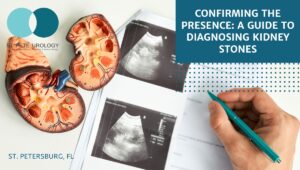Three key takeaways from the article are:
- Kidney stones can cause severe pain in the lower back or flank area, accompanied by nausea and vomiting.
- Diagnosis typically includes a urinalysis, blood test, imaging tests and/or a urine culture.
- Treatment may involve diet/lifestyle adjustments, medications, and/or surgery/endoscopic procedures, and prevention is best achieved by drinking plenty of water, eating a healthy diet and exercising regularly.
I. Introduction


A. Definition of kidney stones
Kidney stones are hard structures that form in the urinary tract due to an accumulation of mineral deposits. They can cause painful urination and back or abdominal pain.
B. Statistics & prevalence of kidney stones
According to the National Institute of Diabetes and Digestive and Kidney Diseases, kidney stones affect about 5% of people in the United States each year. The prevalence is higher for men than women and for people between the ages of 30 and 60.
II. Signs & Symptoms of Kidney Stones
A. Pain and discomfort
The most common symptom of a kidney stone is severe pain, which usually start in the lower back or flank area. The pain may range from a dull ache, to sharp and intense, and can last between 20 minutes to an hour.
B. Nausea & vomiting
The pain may also be accompanied by nausea and vomiting.
C. Flank and lower back pain
Pain in the lower back or flanks is a common sign of a kidney stone. It can be caused by the stone passing through the ureter or the muscle spasms they cause.
D. Bleeding, hematuria and fever
Less common symptoms include urine that is bloody, pink, or dark in color, along with fever, chills, and nausea.
III. Diagnosis of Kidney Stones
A. Urinalysis and blood tests
A doctor may order urinalysis, blood tests, and a urine culture to help determine the presence of a kidney stone. The tests typically measure levels of certain electrolytes or blood cells, or indicate kidney function or urinary tract infections.
B. Imaging with X-Ray, CT scan or ultrasound
Imaging tests such as x-ray, CT scan or ultrasound may be ordered to be taken to view the size and location of the kidney stone or evaluate the functioning of the kidney, ureter and bladder.
C. Ureteroscopy and lithotripsy (stone removal)
If the kidney stone is too large to pass on its own, a procedure called a ureteroscopy or lithotripsy may be performed to break up the stone and remove it.
IV. Treatment of Kidney Stones
A. Diet & lifestyle adjustments
Making dietary and lifestyle adjustments such as reducing sodium, increasing water intake and avoiding certain foods can help prevent future kidney stones.
B. Medications
Medications may be prescribed to help manage the pain and reduce the size of the stones.
C. Surgery or endoscopic procedures
In some cases, surgery or an endoscopic procedure may be necessary to remove the stones.
V. Conclusion
A. Summary of the diagnosis and treatment of kidney stones
Kidney stones can be painful and inconvenient, but thankfully, there are various steps that may be taken to diagnose, treat and prevent them. Diagnosis typically starts with a urinalysis or blood test, followed by imaging tests such as x-ray or ultrasound. Medications and diet and lifestyle adjustments may help. However, in some cases, surgery or an endoscopic procedure may be necessary.
B. Prevention of kidney stones
The most effective way to prevent kidney stones is to drink plenty of water and reduce your intake of sodium and certain foods. Living a healthy lifestyle involves regular exercise and addressing any medical concerns with a doctor. These steps can help ensure that future kidney stones do not form.
When it comes to kidney stones and other urological issues, the team of doctors at St Pete Urology are here to help. Located in St Petersburg, Florida, our practice is home to a compassionate and knowledgeable team dedicated to providing complete and comprehensive urological care. From diagnosis and treatment to prevention and patient education, our team is here for you. Contact us today to learn more about our services and schedule an appointment.
REFERENCES:
- “National Institute of Diabetes and Digestive and Kidney Diseases ….” https://www.nih.gov/about-nih/what-we-do/nih-almanac/national-institute-diabetes-digestive-kidney-diseases-niddk.
- “Kidney stones – Symptoms, causes, types, and treatment.” https://www.kidney.org/atoz/content/kidneystones.
- “Ureteroscopy | Johns Hopkins Medicine.” https://www.hopkinsmedicine.org/health/treatment-tests-and-therapies/ureteroscopy.




